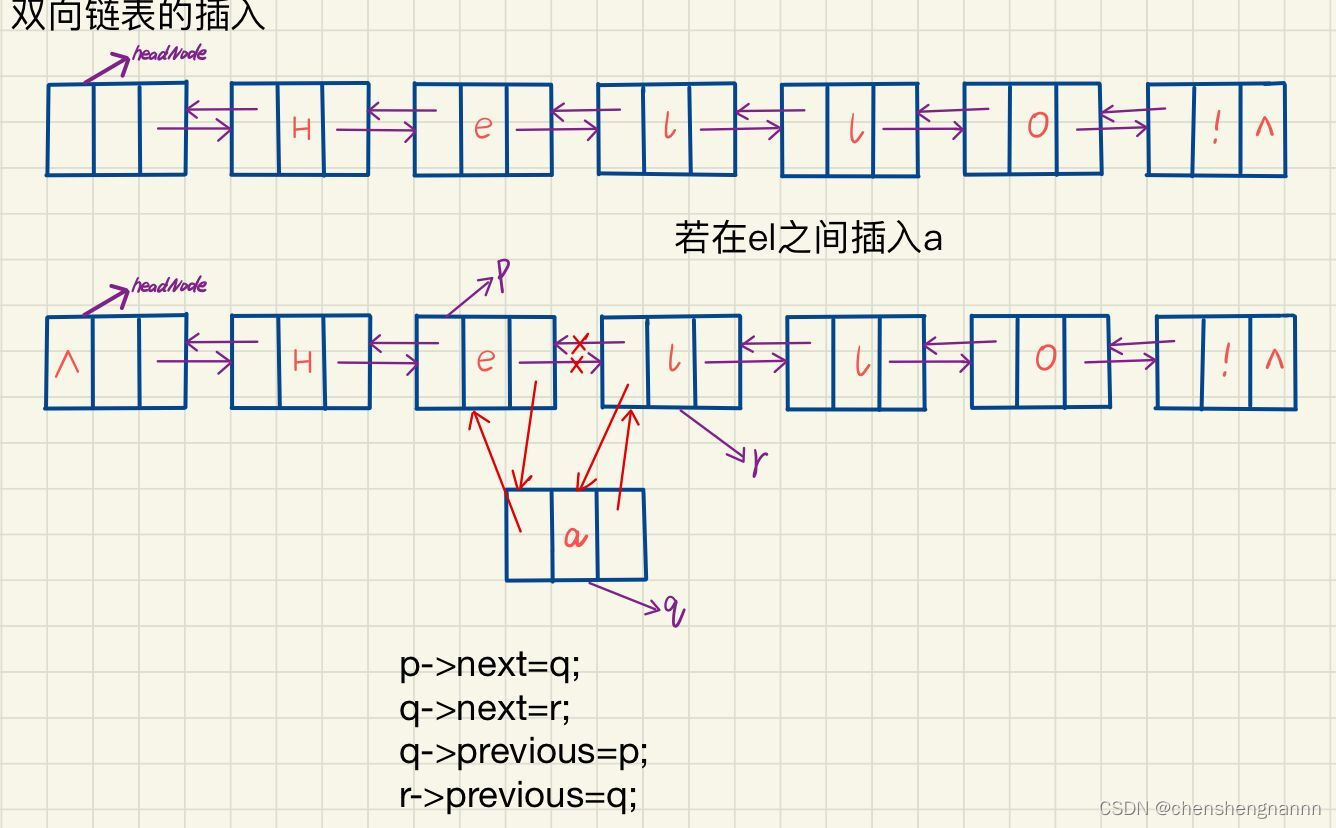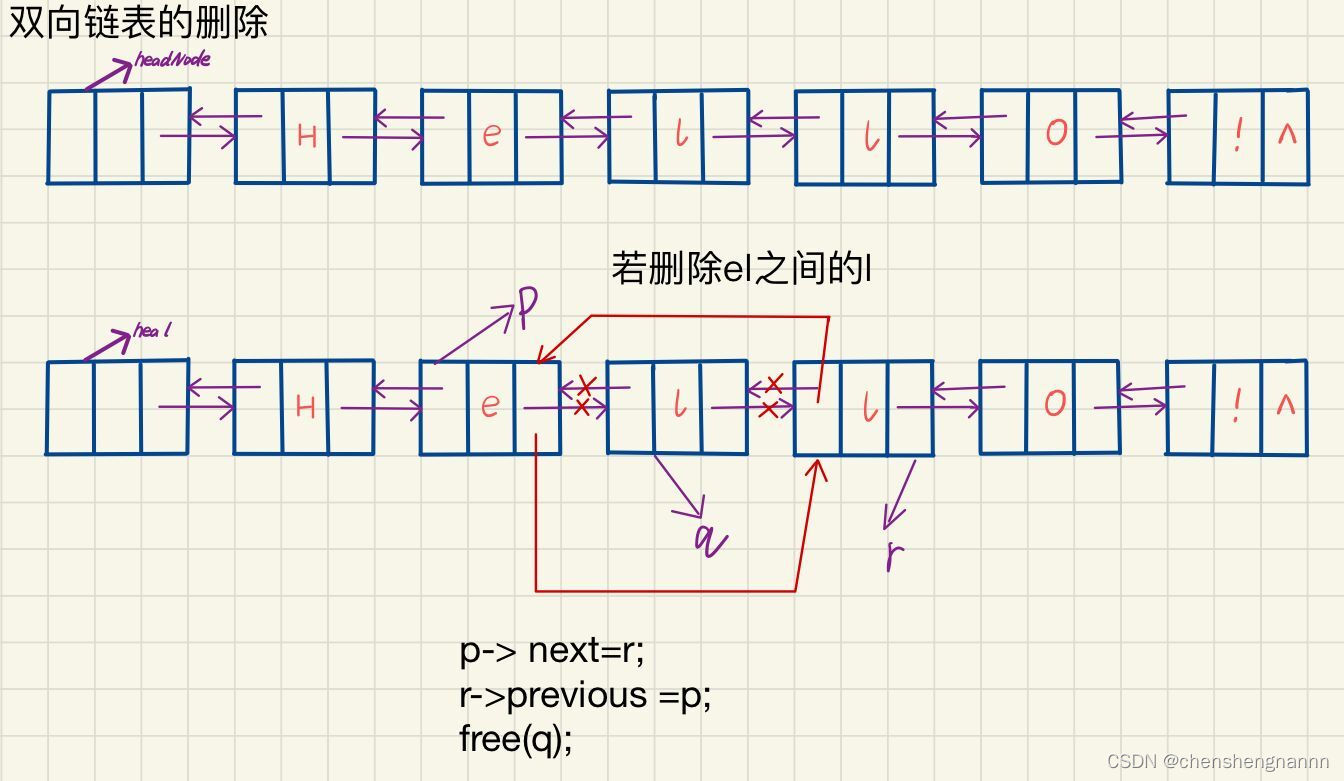一、老师的代码
一、源代码
二、测试结果
二、自己的代码
一、储存结构
二、初始化
三、打印
四、按位查找
五、求前驱
六、按位插入
七、按位删除元素
八、删除固定元素
九、统计元素个数
十、摧毁链表
十一、插入删除测试
十二、地址打印
十三、main函数
十四、测试结果
十五、总结
一、老师的代码
一、源代码
#include <stdio.h>
#include <malloc.h>
typedef struct DoubleLinkNode
{
char data;
struct DoubleLinkNode *previous;
struct DoubleLinkNode *next;
}DLNode,*DLNodePtr;
//双向链表的初始化
DLNodePtr initLinkList()
{
DLNodePtr tempHeader=(DLNodePtr)malloc(sizeof(DLNode));
tempHeader->data ='\0';
tempHeader->previous =NULL;
tempHeader->next =NULL;
return tempHeader;
}
//双向链表的打印
void printList(DLNodePtr paraHeader)
{
DLNodePtr p = paraHeader->next;
while(p!=NULL)
{
printf("%c ",p->data);
p = p->next;
}
printf("\r\n");
}
//元素的按位插入
void insertElement(DLNodePtr paraHeader,char paraChar,int paraPosition)
{
DLNodePtr p,q,r;
int i;
p=paraHeader;
//先找到位置
for(i=0;i<paraPosition;i++)
{
p=p->next;
if(p==NULL)
{
printf("The position %d is beyond the scope of the list",paraPosition);
return ;
}
}
//为插入的元素分配内存
q = (DLNodePtr)malloc(sizeof(DLNode));
q->data = paraChar;
q->next = NULL;
q->previous = NULL;
//开始插入
r = p->next;
p->next = q;
q->previous = p;
q->next = r;
if(r!=NULL)
{
r->previous = q;
}
}
void deleteElement(DLNodePtr paraHeader,char paraChar)
{
DLNodePtr p,q,r;
p = paraHeader;
while((p->next!=NULL)&&(p->next->data!=paraChar))
{
p=p->next;
}
if(p->next==NULL)
{
printf("The char %c does not exist.\r\n",paraChar);
return ;
}
q=p->next;
r=q->next;
p->next=r;
if(r!=NULL)
{
r->previous=p;
}
free(q);
}
void insertDeleteTest(){
// Step 1. Initialize an empty list.
DLNodePtr tempList = initLinkList();
printList(tempList);
// Step 2. Add some characters.
insertElement(tempList, 'H', 0);
insertElement(tempList, 'e', 1);
insertElement(tempList, 'l', 2);
insertElement(tempList, 'l', 3);
insertElement(tempList, 'o', 4);
insertElement(tempList, '!', 5);
printList(tempList);
// Step 3. Delete some characters (the first occurrence).
deleteElement(tempList, 'e');
deleteElement(tempList, 'a');
deleteElement(tempList, 'o');
printList(tempList);
// Step 4. Insert to a given position.
insertElement(tempList, 'o', 1);
printList(tempList);
}// Of appendInsertDeleteTest
/**
* Address test: beyond the book.
*/
void basicAddressTest(){
DLNode tempNode1, tempNode2;
tempNode1.data = 4;
tempNode1.next = NULL;
tempNode2.data = 6;
tempNode2.next = NULL;
printf("The first node: %d, %d, %d\r\n",
&tempNode1, &tempNode1.data, &tempNode1.next);
printf("The second node: %d, %d, %d\r\n",
&tempNode2, &tempNode2.data, &tempNode2.next);
tempNode1.next = &tempNode2;
}// Of basicAddressTest
/**
* The entrance.
*/
void main(){
insertDeleteTest();
basicAddressTest();
}// Of main二、测试结果

二、自己的代码
一、储存结构
#include <stdio.h>
#include <malloc.h>
#include <stdlib.h>
//双向链表的储存结构
typedef struct doubleListNode
{
char data;
struct doubleListNode *previous;
struct doubleListNode *next;
}DLNode,*DLNodePtr;二、初始化
//初始化
DLNodePtr initDoubleList()
{
DLNodePtr headNode = (DLNodePtr)malloc(sizeof(DLNode));
headNode->data = '\0';
headNode->previous = NULL;
headNode->next = NULL;
return headNode;
} 三、打印
//打印链表
void printList(DLNodePtr list)
{
DLNodePtr p = list->next;
while(p!=NULL)
{
printf("%c",p->data);
p=p->next;
}
printf("\r\n");
}四、按位查找
//按位查找
DLNodePtr searchByLocation(DLNodePtr list,int newPosition)
{
DLNodePtr p;
p = list;
int i;
//找到位置
for(i=0;i<newPosition;i++)
{
p = p->next;
if(p==NULL)
{
printf("The position %d is beyoud the scope of the list. \n",newPosition);
return ;
}
}
printf("The element is %c.\n",p->data);
return ;
} 五、求前驱
//求前驱
DLNodePtr getPriorElement(DLNodePtr list,int newPosition)
{
DLNodePtr p,q,r;
int i;
p = list;
//先找到那个位置上的元素
for(i=0;i<newPosition;i++)
{
p = p->next;
if(p==NULL)
{
printf("The position %d is beyoud the scope of the list. \n",newPosition);
return ;
}
}
printf("The element'prior is %c.\n",p->previous->data);
return ;
}六、按位插入
//按位插入
void insertElement(DLNodePtr list,char newChar,int newPosition)
{
DLNodePtr p,q,r;
//给元素分配位置
q = (DLNodePtr)malloc(sizeof(DLNode));
q->data = newChar;
q->next = NULL;
q->previous = NULL;
//找到要插入的位置
p = list;
int i;
for(i=0;i<newPosition;i++)
{
p = p->next;
if(p==NULL)
{
printf("The position %d is beyond the scope of the list",newPosition);
return ;
}
}
//插入
r = p->next;
p->next = q;
q->previous = p;
q->next = r;
if(r!=NULL)
{
r->previous = q;
}
}
七、按位删除元素
//按位删除元素
void deleteElementByLocation(DLNodePtr list,int newPosition)
{
DLNodePtr p,q,r;
int i;
p = list;
//先找到要删除的元素的位置
for(i=0;i<newPosition;i++)
{
p=p->next;
if(p==NULL)
{
printf("The position %d is beyond the list.\r\n",newPosition);
return ;
}
}
q = p->previous ;
r = p->next ;
q->next = r;
if(r!=NULL)
{
r->previous =q;
}
free(p);
} 
八、删除固定元素
//删除固定元素
void deleteElement(DLNodePtr list,char newChar)
{
DLNodePtr p,q,r;
p = list;
//找到要删除的元素
while((p->next!=NULL)&&(p->next->data!=newChar))
{
p = p->next;
}
if(p->next==NULL)
{
printf("The char %c does not exist.\r\n",newChar);
return ;
}
//删除
q = p->next;
r = q->next;
p->next = r;
if(r!=NULL)
{
r->previous = p;
}
free(q);
}九、统计元素个数
//统计元素个数
int statisticsNumber(DLNodePtr list)
{
int cnt=0;
DLNodePtr p = list;
while(p->next!=NULL)
{
cnt++;
p = p->next;
}
printf("The number of the list is %d.\n",cnt);
return ;
}十、摧毁链表
//摧毁链表
void destroyList(DLNodePtr list)
{
DLNodePtr p = list;
while(p!=NULL)
{
list= list->next;
free(p);
p = list;
}
} 十一、插入删除测试
//插入删除测试
void insertDeleteTest(){
DLNodePtr tempList = initDoubleList();
printList(tempList);
insertElement(tempList, 'H', 0);
insertElement(tempList, 'e', 1);
insertElement(tempList, 'l', 2);
insertElement(tempList, 'l', 3);
insertElement(tempList, 'o', 4);
insertElement(tempList, '!', 5);
statisticsNumber(tempList);
searchByLocation(tempList,2);
getPriorElement(tempList,2);
deleteElementByLocation(tempList,2);
statisticsNumber(tempList);
printList(tempList);
deleteElement(tempList, 'e');
deleteElement(tempList, 'a');
deleteElement(tempList, 'o');
printList(tempList);
insertElement(tempList, 'o', 1);
printList(tempList);
}十二、地址打印
//地址打印
void basicAddressTest(){
DLNode tempNode1, tempNode2;
tempNode1.data = 4;
tempNode1.next = NULL;
tempNode2.data = 6;
tempNode2.next = NULL;
printf("The first node: %d, %d, %d\r\n",
&tempNode1, &tempNode1.data, &tempNode1.next);
printf("The second node: %d, %d, %d\r\n",
&tempNode2, &tempNode2.data, &tempNode2.next);
tempNode1.next = &tempNode2;
}十三、main函数
//main函数
void main(){
insertDeleteTest();
basicAddressTest();
}十四、测试结果

十五、总结
总结就是比前几天更加熟悉链表的操作了






















 2168
2168











 被折叠的 条评论
为什么被折叠?
被折叠的 条评论
为什么被折叠?










